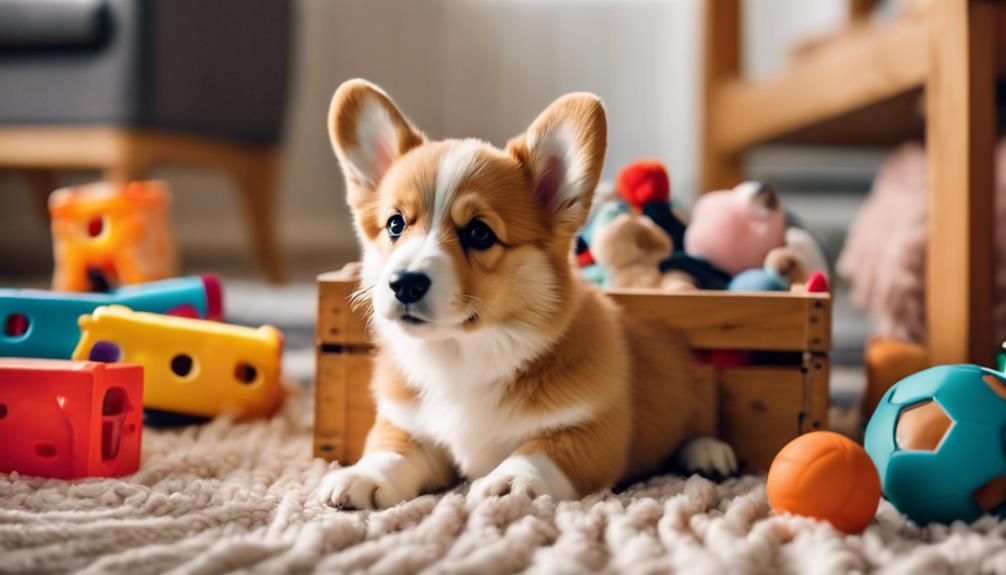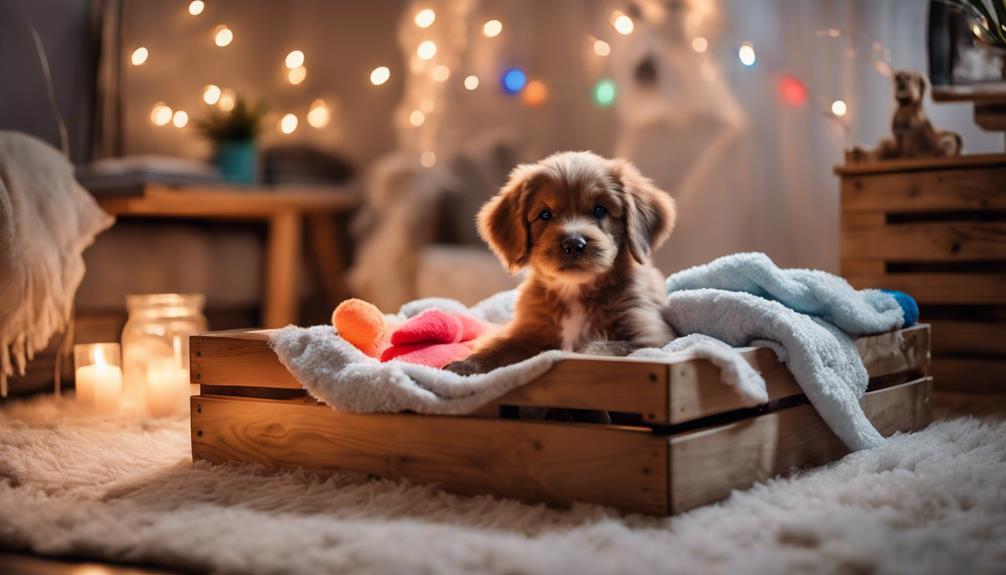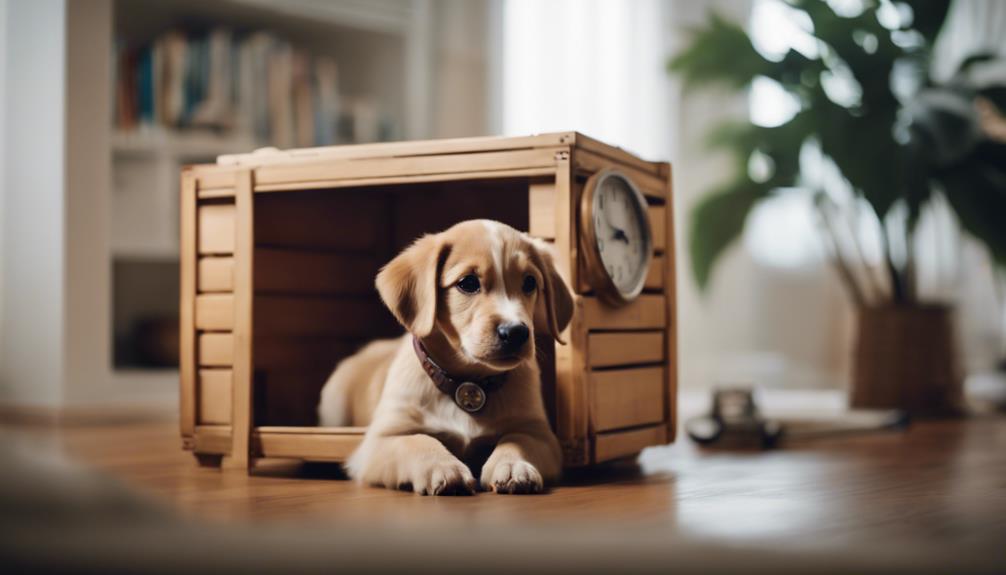Crate training is a fundamental aspect of puppy upbringing, offering both safety and comfort while facilitating effective house training. To achieve this, one must understand the nuances of canine behavior, select an appropriate crate, and create a welcoming environment. Employing positive reinforcement techniques is essential, yet many owners struggle with the initial stages of this process. As we explore the various strategies to optimize crate training, it becomes apparent that the journey extends beyond mere confinement—what lies ahead could transform your puppy's experience and strengthen your bond.
Understanding Corgi Behavior

Understanding Corgi behavior is essential for effective crate training, as their unique traits and instincts can significantly influence their response to confinement.
Corgis are known for their playful nature and strong herding instincts, which can lead to specific behavioral traits. For instance, they might display separation anxiety when left alone, making it crucial to introduce crate training gradually.
Some common corgi quirks include their tendency to bark when bored or anxious, which may intensify during crate training. Additionally, they often enjoy having a cozy space to retreat to, so creating a comfortable environment inside the crate is vital.
Choosing the Right Crate
Choosing the right crate for your puppy is crucial for their comfort and safety.
Important considerations include crate size, as it should allow your puppy to stand, turn around, and lie down comfortably.
Additionally, the material used should be durable enough to withstand any chewing or scratching.
Crate Size Considerations
Selecting the appropriate crate size is crucial for ensuring your puppy feels secure and comfortable while fostering a positive association with their new space.
When choosing a crate, consider the crate dimensions relative to your puppy's current size and anticipated growth. A crate that is too large may allow your puppy to eliminate in one corner and still have space to sleep in another.
Ideally, the crate should provide enough room for your puppy to stand up, turn around, and lie down comfortably. As puppies grow quickly, look for adjustable options or dividers that can accommodate their changing needs.
This thoughtful approach helps create a safe environment, promoting successful crate training and a happy, well-adjusted puppy.
Material and Durability
The material and durability of a crate play a significant role in ensuring safety and longevity for both the puppy and the crate itself.
When choosing a crate, consider different crate materials, such as metal, plastic, and fabric. Metal crates offer strength and ventilation, while plastic provides a lightweight alternative ideal for travel. Fabric crates, though portable, may not withstand rough use.
Look for durability features like reinforced corners, secure latches, and chew-resistant materials. A well-constructed crate can prevent accidents and injuries, making it a safe haven for your puppy.
Additionally, ensure the crate is easy to clean, as hygiene is vital for your puppy's health. Selecting a durable crate will help create a positive training environment for your puppy.
Preparing the Crate Environment

Preparing the crate environment is essential for making it a safe and inviting space for your puppy.
Key elements include choosing the right crate size, adding comfort items like blankets and toys, and ensuring proper ventilation for airflow.
Each of these factors contributes to your puppy's comfort and helps ease the transition into crate training.
Choosing the Right Crate
Finding a suitable crate involves considering your puppy's size, breed, and individual temperament to ensure a comfortable and secure environment.
There are various crate types, including wire, plastic, and soft-sided options, each offering unique benefits. Wire crates provide ventilation and visibility, while plastic crates are ideal for travel and security. Soft-sided crates are lightweight and portable.
When selecting a crate, it's essential to consider crate accessories that enhance safety and comfort. Accessories such as dividers can adjust the space as your puppy grows, while crate mats offer added cushioning.
A well-chosen crate serves as a safe haven for your puppy, promoting positive associations and effective training. Ultimately, investing time in choosing the right crate lays the foundation for successful crate training.
Adding Comfort Items
Incorporating comfort items into your puppy's crate can significantly enhance their sense of security and well-being during training sessions. These items can include soft blankets, favorite toys, or even an item of your clothing, which carries your scent. The familiar smells can provide reassurance, making the crate feel more like a safe haven.
Additionally, consider using soothing scents, such as lavender, which can help calm your puppy. When selecting comfort items, ensure they are safe and appropriate for your puppy's size and chewing habits.
Regularly rotate items to maintain interest and prevent boredom. By thoughtfully preparing the crate environment, you foster a positive association with the space, supporting effective crate training and emotional comfort for your puppy.
Ensuring Proper Ventilation
Proper ventilation is essential for creating a comfortable and safe crate environment for your puppy, as it helps regulate temperature and airflow, preventing overheating and ensuring they feel secure. Understanding the ventilation importance is crucial for pet owners.
To achieve effective airflow management, consider the following tips:
- Choose a crate with proper ventilation holes or slats, allowing fresh air to circulate.
- Position the crate in a cool, shaded area, away from direct sunlight.
- Avoid overloading the crate with bedding, as this can restrict airflow.
- Monitor the temperature and humidity levels inside the crate regularly.
Gradual Introduction to the Crate
A gradual introduction to the crate is essential for ensuring that your puppy feels comfortable and secure in their new space. Start by placing the crate in a common area, allowing your puppy to explore it at their own pace.
Use crate acclimation techniques such as leaving the door open and placing your puppy's favorite toys inside. Gradual crate exposure helps your puppy associate the crate with positive experiences.
Feed your puppy near the crate, so they begin to relate it to mealtime. Over several days, encourage your puppy to enter the crate on their own. This method reduces anxiety and fosters a sense of safety.
Positive Reinforcement Techniques

Utilizing positive reinforcement techniques is crucial for effectively crate training puppies, as it encourages desired behaviors and fosters a trusting relationship between the owner and the pet.
One popular method is clicker training, which uses a click sound to signal to the puppy that they have performed the correct behavior. This technique can be combined with reward timing, ensuring that treats or praise are given immediately after the desired action occurs.
For example, when a puppy enters the crate voluntarily, the click should follow, along with a treat. This association helps the puppy understand what action is being rewarded.
Consistency and patience are essential, as they reinforce learning and help the puppy feel secure in their crate environment.
Establishing a Routine
Establishing a consistent routine is vital for successful crate training, as it helps puppies understand when to expect crate time and reinforces their learning through predictable patterns.
A daily schedule should include regular feeding times, bathroom breaks, and play sessions, all of which contribute to a well-rounded training timeline. For example, feed your puppy at the same time each day, followed by a bathroom break before crate time. This consistency allows puppies to anticipate their needs and reduces anxiety.
Additionally, designate specific times for crate training practice, ensuring that these sessions are short, positive, and rewarding. Over time, this structured approach fosters a sense of security, making the crate a comfortable space for your puppy.
Dealing With Whining and Crying

Whining and crying are common behaviors in puppies during crate training, often indicating distress or a need for attention. Understanding the whining triggers, such as loneliness or discomfort, is crucial for effective training.
To address these behaviors, consider implementing calming techniques. First, ensure the crate is a comfortable space with soft bedding and favorite toys. Gradually introduce your puppy to the crate for short periods, increasing duration over time.
When your puppy begins to whine, avoid immediate attention, as this may reinforce the behavior. Instead, wait for a brief pause before rewarding quietness. Additionally, soothing sounds, like soft music, can help create a calming environment.
Consistent application of these strategies will help reduce whining and foster a positive crate experience.
Crate Training for Potty Training
Effective crate training can significantly aid in the potty training process for puppies by leveraging their natural instincts to avoid soiling their sleeping area.
When establishing a crate schedule, it is vital to observe your puppy's habits. Take them outside after meals, playtime, or naps, as these are key moments when they are likely to need to relieve themselves.
Keep the crate clean and comfortable to encourage your puppy to view it as a safe space. Additionally, reward your puppy for eliminating outdoors to reinforce positive behavior.
Consistency is crucial; maintain regular feeding and potty schedules. Over time, your puppy will learn to associate the crate with a clean sleeping environment, successfully aiding their potty training journey.
Maintaining Consistency and Patience

Consistency and patience are key components in successful crate training, as they help reinforce the puppy's understanding of expected behaviors and routines.
Establishing a training schedule is essential; this creates a predictable environment where the puppy can thrive. For example, designate specific times for crate use, feeding, and potty breaks.
Additionally, employing a reward system will motivate your puppy to engage positively with the crate. When your puppy enters the crate willingly or remains calm inside, offer treats or praise. This reinforces desirable behaviors, making the crate a safe and enjoyable space.

